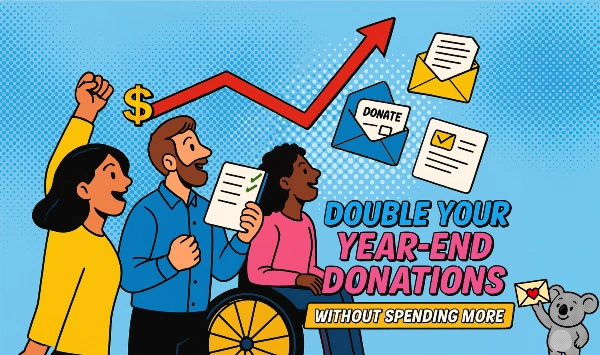Stories are important for fundraising. They can make the difference between success and failure.
But they aren’t the only thing going on in an effective fundraising message.
They aren’t even the most important thing.
A story is an ingredient for fundraising.
One of the dangers we face when we tell stories is we can fall in love with those stories and make them the focus of our messages. This can happen when we have a powerful story to tell: Our message turns into a vivid display of the amazing story, at the expense of connecting with the donor about how their giving can make the world a better place.
I’m going to show you a four-page direct mail appeal I wrote awhile back. I had an unusually strong story to work with, and I was tempted to over-focus on it by using the techniques of creative writing and journalism. Fortunately, I caught myself in time and turned it back into a fundraising message.
Below is a complete direct mail appeal for a nonprofit hospital in the US, with commentary to show you how the story became an ingredient of a call to action. (Many details have been changed to protect the privacy of the person in the story and the organization the appeal was written for.)
The letter opens by introducing Phil’s story in a general way, being sure to connect the donor’s life with his story, making it clear we’re talking about the importance of the emergency room in the community.
Dear [Name], What happened to Phil Sanchez is like something you’d see in a very tense movie. But it could happen to anyone. Including you. Or someone you love -- a family member, a child, a neighbor ... Suddenly a life may be in danger ... you don’t really know. You just know they need help. Minutes count -- even seconds. That’s when the Emergency Room makes all the difference. It can be a life-saver! I’ll tell you what happened to Phil in a minute. Whether you’ve been through something like it -- helping someone else, or maybe the one who got help, you know how much the ER means.
After five (short) paragraphs, all we know is the name of the person in the story and that it has something to do with an Emergency Room. A fiction writer or journalist would not do this – they’d dive right in to the drama. But we aren’t there yet. Before going on to the story, the letter takes another four paragraphs to direct the donor to think about their own connection with the organization, then it makes the first ask for a donation with specific suggested amounts:
I’m writing to you today because you get it. Your support of [Organization] shows me that you understand how important great healthcare is in our community.
That’s why I’m asking you today to make a donation. You help keep the ER — and all the other life-saving services available for you, your loved ones, and your neighbors. It’s so very important!
Would you please consider a donation to [Organization] of $XX1, $XX2, $XX3 … or any amount — large, or small, or in between?
You’ll help make all the difference for people when they most need help … and that could be you or someone you love…
You’ll really see how important this is when I tell you Phil’s story. Hang on, because it’s frankly terrifying…
Finally, we get to the story, starting at the beginning:
When Phil, a writer, woke up one January morning, he had a strong sense of dread. As if something terrible was going to happen. We’ve all experienced that sort of feeling, and usually we don’t take it too seriously. Well, Phil decided not to go anywhere that day. Just a precaution, because of his “premonition.” He and his wife Dee decided to go for a walk in the woods near their home. They took their two youngest kids, ages 4 and 5, with them.
I knew quite a bit more about Phil than I included here. I knew more about his career, which was quite interesting – but not really apropos to this story. A journalist would have included that. I also knew his wife’s job: She was a nurse at the hospital I was writing for. Interesting, right? Sure, but it was a complication, so I left it out. I also knew the kids’ names. They would have been included in the news story, but not here.
A nice, safe family walk. About a quarter-mile into their walk, they came to the creek, and as they’d done many times before, they started to cross it by a massive log. That’s when it happened. When Phil was half-way across, the bank of the creek collapsed. Phil and the log plunged into the water. The log landed on top of Phil and crushed him against the creek’s rocky bed, about four feet under water. Fortunately, the log then bounced upward, and Phil got his head above water. He started screaming for help, but soon passed out. Dee jumped into the icy, fast-flowing creek and managed to drag him to the bank. She could clearly see that something was terribly wrong. He was only bleeding from his finger, but as Dee put it, “he had the death mask.” He was critically injured and in shock already. What she didn’t know was that he was badly bleeding internally. A main was blown open. His stomach was punctured and torn. His left lung compressed. His right kidney’s blood supply cut off. One doctor later said the accident “tore his digestive system in two.” He also broke several ribs and three vertebrae.
Midway through the story, right at its climax, the appeal turns back to the donor, to make it clear how this story is relevant and important to her. That leads to the second direct ask for a donation:
[Name], I really hope nothing this serious ever happens to you or anyone close to you. But the thing is, many of us at some point need emergency care. [Organization] is there for you when you need it. And, as a not-for-profit community resource, we depend in part on generous donations from friends like you. Your gift to [Organization] makes sure we can be there -- equipped with the latest medical technology -- for those times when we are needed most! Will you consider a donation to [Organization] today?
We now return to the story for its conclusion. You’ll notice that a lot of detail is quickly moved through:
But let me tell you what happened next with Phil. Remember, they were just a quarter mile from their house when the log crushed him. That might not seem like a big distance. Until you remember what Dee was up against: A gravely injured husband unconscious and unable to talk. Two preschoolers -- could she leave them there by the creek with him? She knew it was life or death, and even the slightest delay could be fatal for Phil. So she told the kids to stay with their daddy, and she struggled through tangled blackberry and thick underbrush up a steep slope to the nearest house, where they called 911 while she ran back down to be with Phil and the kids. The emergency medics were there in minutes -- though it didn’t seem fast to Dee as she waited with Phil in her arms, his life draining away. He was finally helicoptered to the emergency room. That’s when things got difficult for Phil. I’ll summarize for you: Emergency surgery. Three days in an induced coma. More surgeries. Five weeks in intensive care. 40 days in the hospital. Months of recovery. It was a long, long road from the day a log crushed Phil to where he is today. He knows the many professionals at [Organization] saved his life. As you can imagine, he gets very emotional when he talks about it.
Again, we return to the donor and really zero in on what the story means for her:
Here’s the important thing I want to tell you: It could happen to anyone. In fact, emergency care happens to a lot of people. You’ve probably been there yourself. Not as dramatic as what happened to Phil (thank goodness!) but it’s a fact of life! The top three types of injuries that send people to the ER?
-
Bicycle accidents
-
Lawn mower accidents
-
Swimming accidents
They’re just everyday activities, things we all do ... and then something goes wrong.
Another direct ask, the third so far:
Please think about making a special donation to [Organization]. You’ll help make the best care available ... and it will be there for you, your family, and your whole community. This is a not-for-profit community health resource. We don’t exist to make money, but to serve the community. That’s why your donation matters. Look at the enclosed reply coupon. Then get your pen and write a check for whatever amount is right for you. Drop it in the mail. Or give online at [Giving page URL]. You can give in honor of a loved one. Or in memory of someone who has passed. I’ve enclosed a map of all the [Organization] emergency rooms. I hope you won’t need it, but if you do, your visit to the nearest one could save a life! Thank you for caring, and I hope to hear from you soon! Sincerely, [Signer] [Organization]
The P.S., as it should briefly retates the point of the letter (but not the story) and makes the fourth ask:
P.S. Your kind donation to [Organization] will make sure we have the emergency care -- and all the other care -- ready for everyone who needs it. Every penny you give will stay here in the community -- and makes all of us healthier and stronger.
I had a number of interesting pieces of information that I considered using for lifts:
- There was an article in the local paper – well-written and very detailed, including several photographs.
- Phil had hand-drawn a map/schematic showing how his accident happened. Fascinating!
- Interviews with two of Phil’s doctors – articulate and detailed.
As tempting as they were, I didn’t use any of those things.
Instead, I sent something that was not directly about Phil, but more about the donor: A map of nearby emergency rooms. I wanted to donor to be thinking about the importance of the organization in her life … not just Phil’s.
I should note that this appeal is more story-focused than most of the fundraising messages I write. That’s because it was more dramatic than most of the stories I have to work with. Most often, the “story” takes two to five paragraphs to tell (interrupted at least once by an ask).
I should also point out that I included a lot more about the “solution” part of Phil’s story than I usually do, because it is also dramatic material. And my instinct told me I could not leave Phil broken and gasping beside a creek without telling what happened next!
Here’s the most important thing about storytelling in fundraising: The “real” story isn’t that amazing story you have about someone other than the donor. The real story is about the donor – what are they going to do next? The story of Phil is there to grab the donor’s attention and make them feel the situation.
That’s how you tell stories that move people to give.
Your critical year-end fundraising is just around the corner. How’d you like to DOUBLE your income from that campaign? Find out how at our all-new webinar, Double Your Year-End Donations Without Spending More. Sean Triner will lay out the complete plan that can dramatically boost your income this year!
Please share your experience by leaving your reply below. We’d love to learn from your experience.











